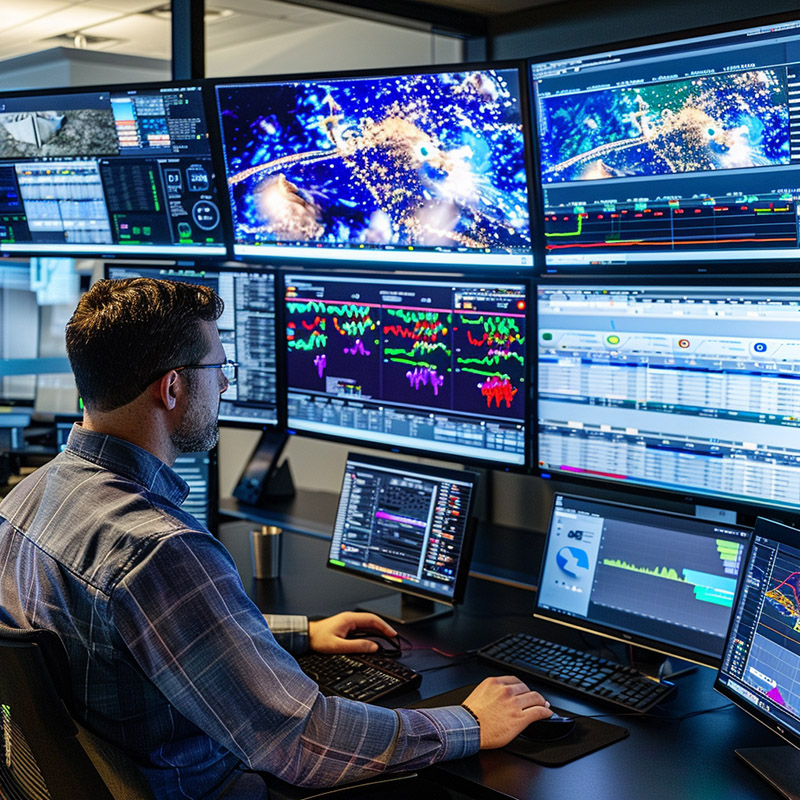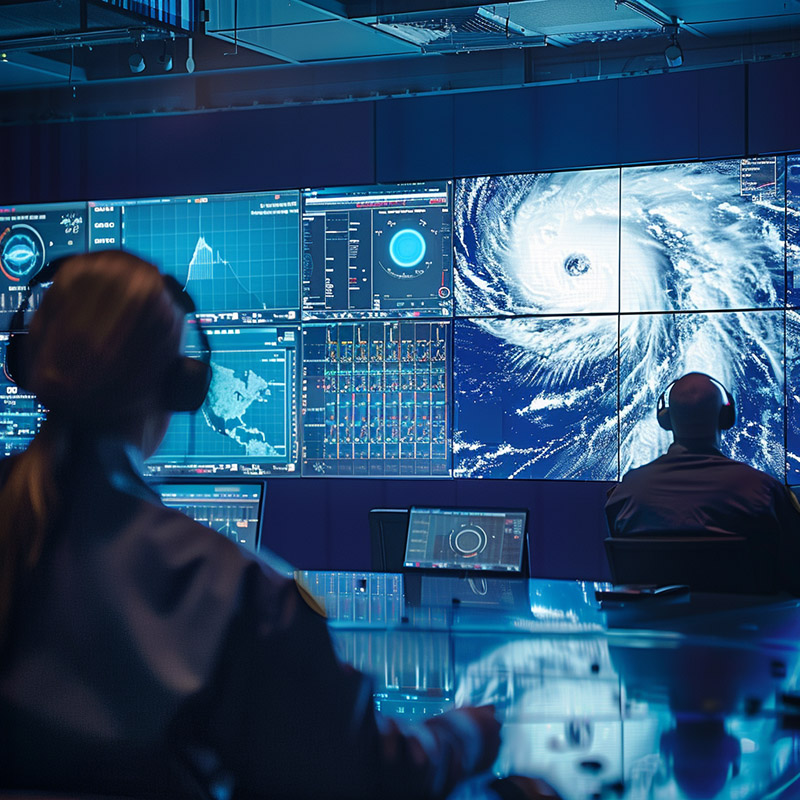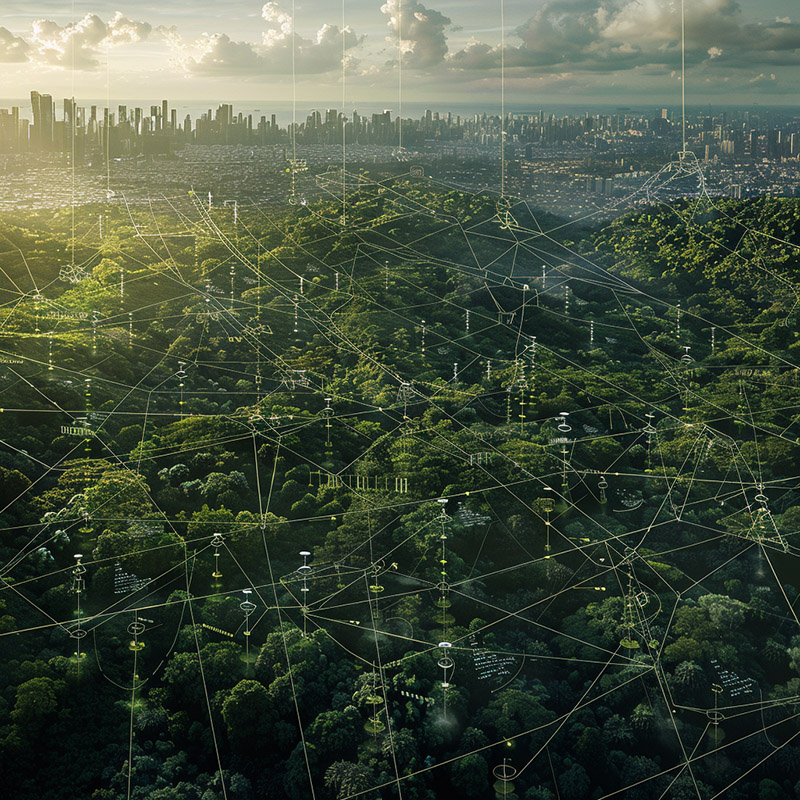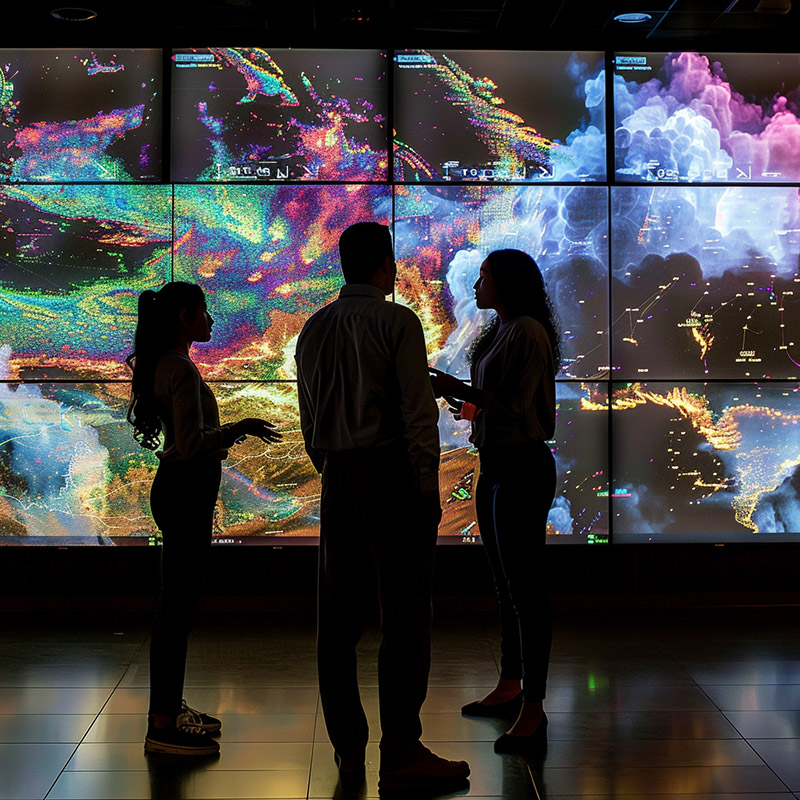1. Enhanced Data Analysis
AI algorithms can process vast amounts of meteorological data from satellites, radars, and ground stations more efficiently than traditional methods, identifying patterns and anomalies that might indicate evolving weather conditions.

Data Analysis Before AI
Meteorologists manually sifted through vast amounts of data from various sources, a time-consuming process that could delay the analysis and dissemination of weather forecasts.
Data Analysis After AI
AI automates the analysis of meteorological data, efficiently identifying patterns and anomalies that indicate changing weather conditions. This rapid processing allows for quicker, more accurate forecasts, enabling timely warnings and better preparedness for weather events.
2. Improved Forecast Accuracy
By learning from historical weather data, AI models can predict future weather events with greater precision, reducing the margin of error in short-term and long-term forecasts.

Forecasts Before AI
Weather predictions were often based on broad models that could not account for all local variables, leading to less accurate forecasts, particularly for longer-term predictions.
Forecasts After AI
AI enhances forecast accuracy by incorporating a wide range of data and continuously learning from past outcomes. This results in more reliable short-term and extended forecasts, reducing uncertainty and helping individuals and industries make informed decisions.
3. Severe Weather Prediction
AI is instrumental in predicting severe weather events, such as hurricanes, tornadoes, and floods, with increased lead time, allowing for better preparedness and potentially saving lives and property.

Prediction Before AI
Predicting severe weather events like hurricanes and tornadoes was challenging, with limited lead times for warnings, often resulting in inadequate preparation time for communities.
Prediction After AI
AI's advanced predictive capabilities significantly increase the lead time for severe weather warnings, enabling more effective emergency planning and potentially saving lives and reducing property damage by allowing for earlier and more targeted responses.
4. Climate Modeling and Simulation
AI contributes to more accurate climate models by analyzing complex interactions within the Earth's climate system, helping scientists understand climate change impacts and predict future climate scenarios.

Models Before AI
Climate models were less detailed and slower to produce, making it difficult to predict long-term climate changes and their potential impacts accurately.
Models After AI
AI accelerates and refines climate modeling, offering detailed simulations of future climate scenarios. These models help scientists understand potential impacts of climate change more clearly, guiding policy decisions and mitigation strategies.
5. Real-Time Weather Monitoring
AI systems monitor real-time weather conditions, instantly analyzing changes to update forecasts and warnings, keeping the public informed and safe.

Monitoring Before AI
Real-time monitoring of weather conditions was limited by the speed at which data could be collected and analyzed, sometimes resulting in delays in updating forecasts and issuing warnings.
Monitoring After AI
With AI, real-time weather monitoring becomes instantaneous, with continuous updates to forecasts as new data becomes available. This ensures that the public and emergency services have the most current information, improving response times to weather-related emergencies.
6. Optimization of Weather Observation Networks
AI optimizes the placement and operation of weather observation instruments, ensuring data collection is both cost-effective and maximally informative, enhancing the overall quality of weather data.

Observation Before AI
The placement and maintenance of weather observation instruments were often based on fixed protocols, which might not have been optimized for data collection efficiency or cost-effectiveness.
Observation After AI
AI optimizes the deployment and operation of weather observation networks, ensuring that data collection is maximally informative and resource-efficient. This leads to improved weather data quality and coverage, enhancing overall forecasting capabilities.
7. Personalized Weather Services
AI enables the delivery of personalized weather forecasts to individuals and specific industries, such as agriculture and aviation, tailoring information to their unique needs and improving decision-making.

Weather Services Before AI
Weather services provided general forecasts that might not have been directly applicable to individual needs, particularly for specific industries such as agriculture or aviation.
Weather Services After AI
AI enables the delivery of personalized weather forecasts, offering tailored advice and warnings based on individual or industry-specific requirements. This customization improves decision-making and operational planning, directly benefiting various sectors.
8. Atmospheric Research
AI aids atmospheric scientists in uncovering insights about atmospheric processes and weather phenomena by analyzing large datasets that would be overwhelming for human researchers, leading to new understandings and advancements in meteorology.

Atmospheric Research Before AI
Understanding the complexities of atmospheric processes was constrained by the limitations of data analysis, hindering the development of new meteorological theories and models.
Atmospheric Research After AI
AI aids atmospheric research by analyzing large datasets, uncovering new insights into weather phenomena and atmospheric conditions. This accelerates scientific discovery in meteorology, leading to advances in weather forecasting and climate science.
9. Integration with IoT for Smart Cities
In smart cities, AI integrates weather data with IoT devices to automate and optimize responses to weather conditions, such as adjusting energy usage or traffic management, contributing to more resilient urban environments.

Cities Before AI
Cities struggled to adapt to changing weather conditions in real-time, often reacting to weather events rather than proactively managing their impacts on urban infrastructure and services.
Cities After AI
AI integrates weather forecasting with IoT devices in smart cities, enabling automated, real-time responses to weather changes. This proactive management minimizes weather-related disruptions, enhancing urban resilience and citizen safety.
10. Enhanced Cloud Computing and Storage
AI leverages cloud computing for more efficient data storage and processing, facilitating access to and analysis of meteorological data on a scale previously unattainable, further advancing research and forecasting capabilities.

Storage Before AI
The storage and processing of meteorological data were often limited by local computing resources, restricting the amount of data that could be analyzed and used for weather forecasting.
Storage After AI
Cloud computing, enhanced by AI, offers scalable solutions for processing and storing vast amounts of weather data. This enables more complex analyses and the development of sophisticated forecasting models, improving the accuracy and reliability of weather predictions.